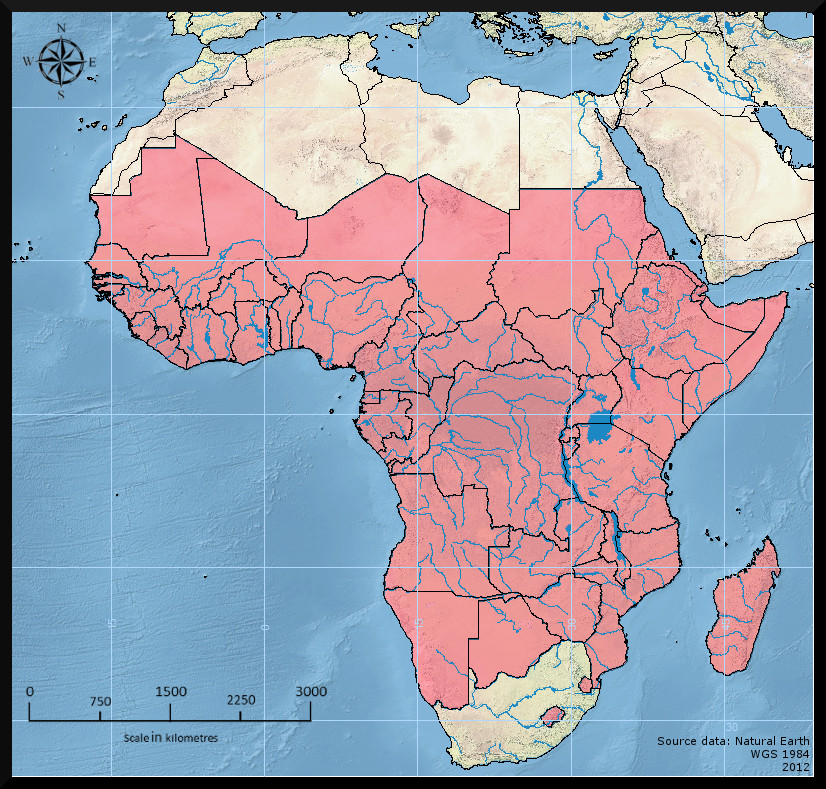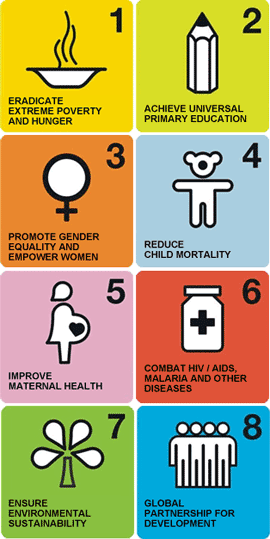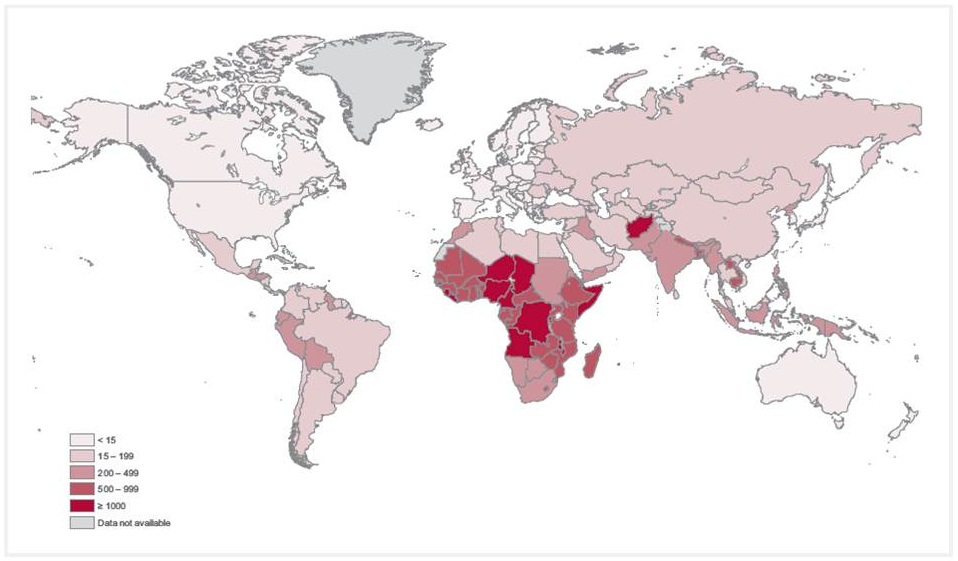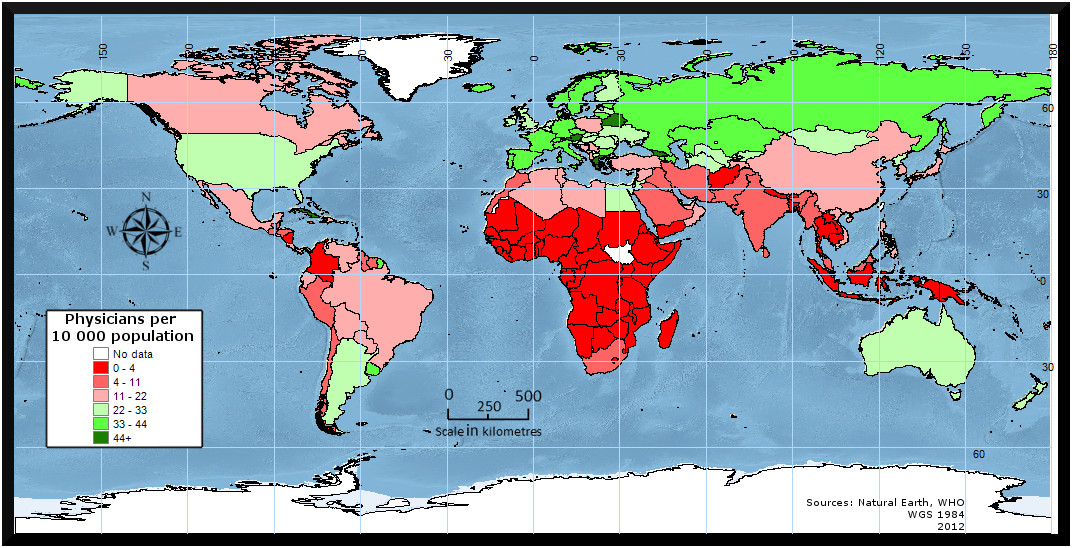| IntroductionThe need for eHSAA brief history of eHSAPhase I (Feasibility Studies)Phase II (Fertilisation Projects)Stakeholders |
Introduction
The Satellite-enhanced eHealth for sub-Saharan Africa Programme (eHSA) is a multi-year programme aimed at establishing sustainable eHealth services in sub-Saharan Africa (SSA). The programme is being managed by ESA, with funding from the European Union – Africa Infrastructure Trust Fund and the Government of Luxembourg through the Luxembourg Agency for Development Cooperation.
Starting with "The Need for eHSA", read on to find a description of the programme on the following pages. The content is organized according to the navigation menu located at the top of this page.
The Need for eHSA
 Sub-Saharan Africa (SSA) is a region comprising 48 countries, which is subject to a very unique set of circumstances. Among the numerous challenges faced by the region is the very high disease burden that is almost ubiquitous in SSA, presenting significant difficulties to the region’s healthcare systems. Furthermore, a number of additional factors prevent healthcare systems from adequately addressing the high disease burden. These factors include the very wide geographic extent of the region, the low penetration of ICTs, and the low population density; all coupled with an inadequate and dwindling health workforce. According to the World Health Organization’s Global Health Observatory, the result of these combined factors is poor health in the region.
Sub-Saharan Africa (SSA) is a region comprising 48 countries, which is subject to a very unique set of circumstances. Among the numerous challenges faced by the region is the very high disease burden that is almost ubiquitous in SSA, presenting significant difficulties to the region’s healthcare systems. Furthermore, a number of additional factors prevent healthcare systems from adequately addressing the high disease burden. These factors include the very wide geographic extent of the region, the low penetration of ICTs, and the low population density; all coupled with an inadequate and dwindling health workforce. According to the World Health Organization’s Global Health Observatory, the result of these combined factors is poor health in the region.

In an attempt to combat poverty, hunger, disease, environmental degradation, illiteracy, and discrimination against women, the United Nations created the Millennium Development Goals (MDGs). All UN member states and many international organizations have agreed to work towards the achievement of these goals by the year 2015.


The goals on reducing child mortality, improving maternal health, and combatting HIV/AIDS, malaria and other diseases directly address health issues in SSA, while the remaining five indirectly contribute to improving health in the region. Two very important conclusions can be drawn:
1. There is an urgent need for solutions to SSA’s healthcare challenges
2. There is a strong desire and motivation coming from heads of state and government to combat these challenges [1].
This has set the stage for eHealth to play a significant role in the future of healthcare in SSA, since eHealth can address many of the aforementioned challenges. This is the context under which the Satellite-enhanced eHealth for sub-Saharan Africa Programme (eHSA) managed by the European Space Agency (ESA) has been conceived.


A brief history of eHSA
The objectives of the Telemedicine Task Force [2] (TTF), which was established in 2006, were to identify a complete set of telemedicine opportunities in SSA, and to put forth recommendations for the future.
Following the TTF’s inception, a number of studies have been completed concerning the technical solutions and cost-benefit analysis of eHealth services in SSA [3]. Among many key conclusions, these documents called for strong African ownership and a very user driven approach within the ensuing programmes and services.
The TTF’s conclusions called for: |
|
SAHEL
The Satellite African e-HEalth Validation (SAHEL) project has been underway since 2010. SAHEL – which is co-funded by the European Commission DG AIDCO and the European partners of the winning consortium – aims to demonstrate the extension of medical eHealth, clinical health, and eHealth management information services in Africa through the use of satellite based technology as a complement to existing ICTs. It is being carried out in Kenya and Senegal.
eHSA
In parallel to the short-term demonstration action of SAHEL, the long-term action has been initiated in the form of the eHSA programme. The eHSA programme is focused on the implementation of long-term of sustainable eHealth services in SSA based on a scalable infrastructure. It will do so by assessing the SSA eHealth-related landscape first, and then by means of fertilisation projects in a number of thematic areas.
The first phase consists of four horizontal feasibility studies, which are succeeded in the second phase by fertilisation projects in a number of thematic areas.
Phase I (Feasibility Studies)
The first phase of the eHSA programme consists of four in-depth horizontal studies. These studies are to last one year, and are addressing critical success factors – setting solid foundations for the development of sustainable eHealth and telemedicine services across SSA. 
The programme is being managed by ESA, with funding from the European Union – Africa Infrastructure Trust Fund and the Government of Luxembourg through the Luxembourg Agency for Development Cooperation. These studies will provide the necessary information to help ensure the success of subsequent fertilisation projects. They will examine the governance, regulatory aspects, interoperability, and sustainability of eHealth services in SSA.
Timeline
- The governance study concluded in March 2013. The study was led by Logica PLC (now part of CGI).
- The regulatory study concluded in April 2013. The study was lead by Greenfield Management Solutions.
- The interoperability study has been launched in May 2013, and is being led by Indra Sistemas S.A.
- The sustainability study was launched in January 2014, and it is being led by Avanti Communications PLC.
- Several workshops and events will be held in Africa to build up the stakeholder community and present results from the studies.
Phase I Studies |
Governance
Regulatory
Interoperability
Sustainability, Liability and Business
|
Phase II (Fertilisation Projects)
Upon completion of the four feasibility studies, up to 16 opportunities shall be selected and realised through demonstration projects in the four eHealth thematic areas of the programme. These projects are to be deployed in different regions of SSA, with the aim of attracting the interest of relevant stakeholders and pave the way for the expansion of eHealth services across SSA.
The way forward
It is envisioned that fertilisation projects will be able to transition from smaller scale, ESA-implemented projects to larger scale, economically sustainable eHealth services owned, operated, and maintained by African stakeholders. The whole eHSA programme is envisioned to attract stakeholders, whom may take on more active leading roles and guide the projects into their operational phases. Infrastructure established during the projects will remain in the ownership of stakeholders in SSA for the benefit of the population.
eHSA Thematic Areas |
eCare eCare refers to the use of ICTs and automation to support any aspect of the healthcare delivery process. While there are a vast array of services that can constitute eCare, a few examples of projects may include remote diagnostics, teleconsultation, or patient self-help services. eLearning eLearning refers to learning or teaching that is supported by ICTs. For the eHSA programme, this is vital, in that it will provide healthcare workers in remote and rural areas of SSA with access to educational resources to which they may not have previously had access. This can include Continuing Medical Education (CME) activities and specialist training, but also virtually attending lectures at major medical centres, global networking with specialists and other training opportunities. eSurveillance eSurveillance stems from the field of environmental health, and uses satellite imagery to monitor risk factors (such as climate, weather etc.) to predict potential outbreaks of illness and disease. Furthermore, once an outbreak has occurred, eSurveillance systems can predict the spread, thereby allowing healthcare systems to adequately prepare for anticipated burdens. eGoverment / eAdministration Health information systems can be very complex by nature. Many regions exhibit a constant battle between centralizing such systems and maximizing consistency, and decentralizing such that lower-level health units can optimize their resources. These challenges will be addressed in an SSA context, with the goals of identifying and demonstrating eGovernance and eAdministration services that are ideal for the region.
|
Stakeholders
Stakeholder engagement is seen as a cornerstone for success, sustainability, and legitimacy of the programme. Proper federation of stakeholders and unity towards eHSA’s goals are paramount; as such, relevant stakeholders will be contacted and engaged over the course of the programme.
 It is important that the concept of strong African ownership is given the utmost importance when engaging with the stakeholders. The necessary stakeholders community extends far past the obvious medical-related actors, and includes players from sectors including Information and Communication Technologies (ICT), healthcare, financial, research and government. Stakeholder satisfaction will be used to determine the success of the programme.
It is important that the concept of strong African ownership is given the utmost importance when engaging with the stakeholders. The necessary stakeholders community extends far past the obvious medical-related actors, and includes players from sectors including Information and Communication Technologies (ICT), healthcare, financial, research and government. Stakeholder satisfaction will be used to determine the success of the programme.
[1] KEEPING THE PROMISE – UNITED TO ACHIEVE THE MILLENNIUM DEVELOPMENT GOALS
[2] The TTF was composed of representatives from: the African Union Commission (AUC), the New Partnership for Africa’s Development (NEPAD), the African Development Bank (AfDB), the Communauté Economique et Monétaire de l'Afrique Centrale (CEMAC), the Organisation de Coordination pour la lutte contre les Endémies en Afrique Centrale (OCEAC), the East African Community (EAC), the Economic Community of West African States (ECOWAS), the Secretariat of the African, Caribbean and Pacific Group of States (ACP Sec), the World Health Organization (WHO), the European Commission (EC) and the European Space Agency (ESA).
[3] TTF Report (2007); Cost Benefit Analysis of eHealth Services in sub-Saharan Africa (2008)





 Governance of the eHSA programme is particularly challenging because it addresses the governance of numerous disciplines, which can be showstoppers for the entire programme, including health care, health systems, and ICTs.
Governance of the eHSA programme is particularly challenging because it addresses the governance of numerous disciplines, which can be showstoppers for the entire programme, including health care, health systems, and ICTs. The regulatory environment in SSA is very complex with respect to eHealth and its constituents. A particular challenge is that the regulations are so heterogeneous across the various countries in SSA, as is the actual level of regulation. This study will examine the various regulatory scenarios in SSA, examining aspects such as standards of care, data security and privacy, liability regimes, licencing, and many others. The result will be a regulatory model to complement that of governance, which will be used in the conception of eHealth services as part of phase II of the eHSA programme. The Final Report of the Regulatory Study is available for download at the bottom of this page.
The regulatory environment in SSA is very complex with respect to eHealth and its constituents. A particular challenge is that the regulations are so heterogeneous across the various countries in SSA, as is the actual level of regulation. This study will examine the various regulatory scenarios in SSA, examining aspects such as standards of care, data security and privacy, liability regimes, licencing, and many others. The result will be a regulatory model to complement that of governance, which will be used in the conception of eHealth services as part of phase II of the eHSA programme. The Final Report of the Regulatory Study is available for download at the bottom of this page.  The fourth and final study will focus on all aspects which are necessary for the long-term operation of the eHealth services conceived as part of the eHSA programme. The major challenge in SSA is to ensure that there is an economic model in place which will allow the services to sustain themselves. The outputs will make concrete the financial implications of the envisioned services, and will address issues pertaining to liability. All of these are considered essential in obtaining endorsement at the political level.
The fourth and final study will focus on all aspects which are necessary for the long-term operation of the eHealth services conceived as part of the eHSA programme. The major challenge in SSA is to ensure that there is an economic model in place which will allow the services to sustain themselves. The outputs will make concrete the financial implications of the envisioned services, and will address issues pertaining to liability. All of these are considered essential in obtaining endorsement at the political level.